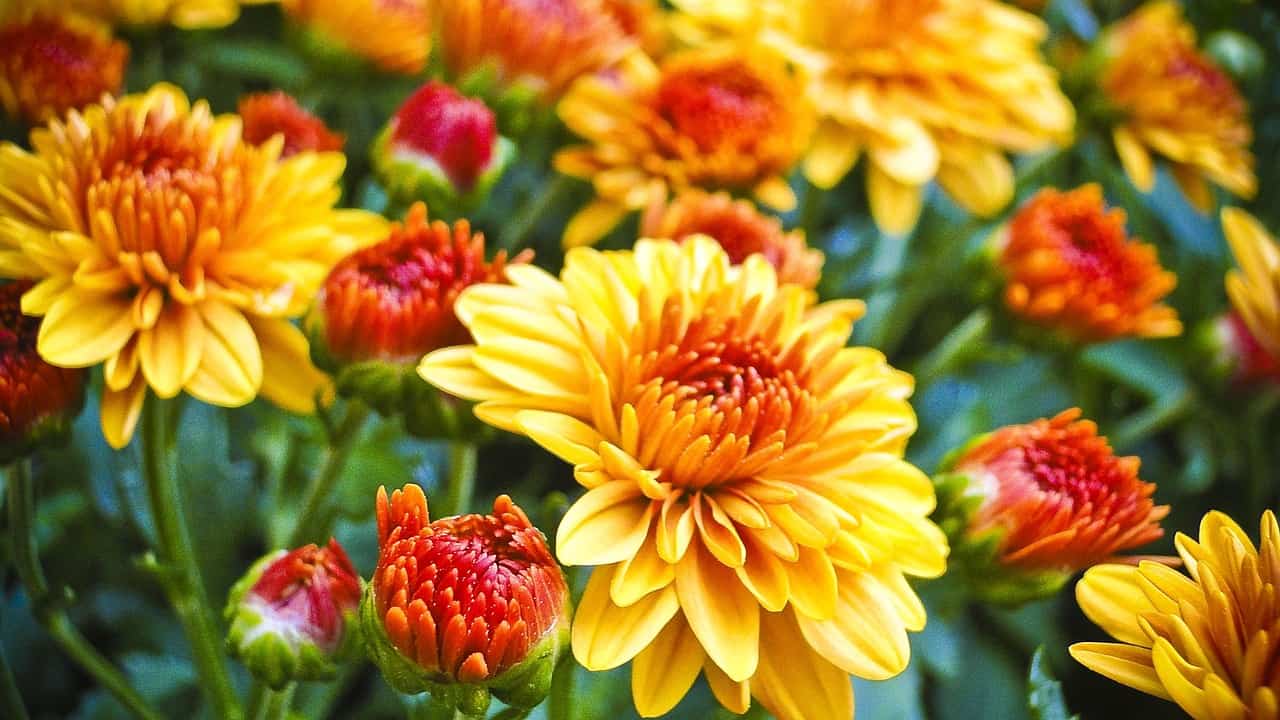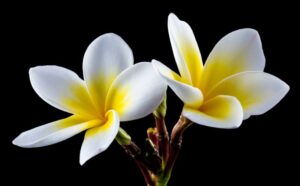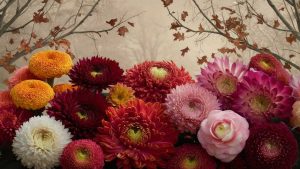As the days grow shorter and the temperatures begin to drop, your Summer annuals will soon start to fade. But don’t despair! There are plenty of beautiful Fall plants that will add color and life to your containers and hanging baskets. Here are a few of our favorites:
Coral Bells (Heuchera cultivars)

Coral bells are perfect for adding a pop of color to your container garden or hanging basket. They come in a variety of colors, including shades of pink, purple, red, and white. Coral bells prefer shady areas and well-drained soil. They are also relatively low-maintenance, so they are ideal for busy gardeners.
Sedum (Sedum, Hylotelephium spp.)
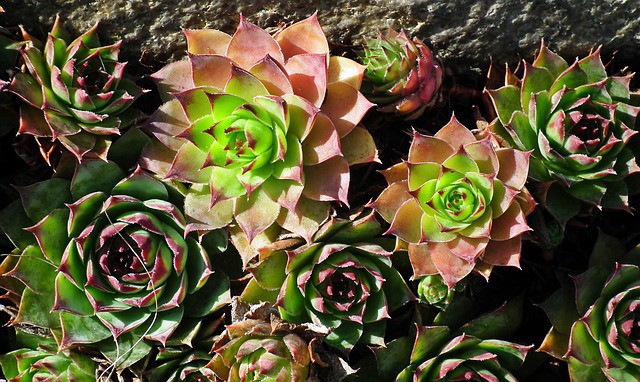
Sedum is a succulent that comes in shades of green, yellow, orange, pink, and red. It prefers full sun but will tolerate some shade. Sedum is drought-tolerant and does not require much watering. It is also one of the easiest plants to propagate from cuttings.
Asters (Aster spp.)
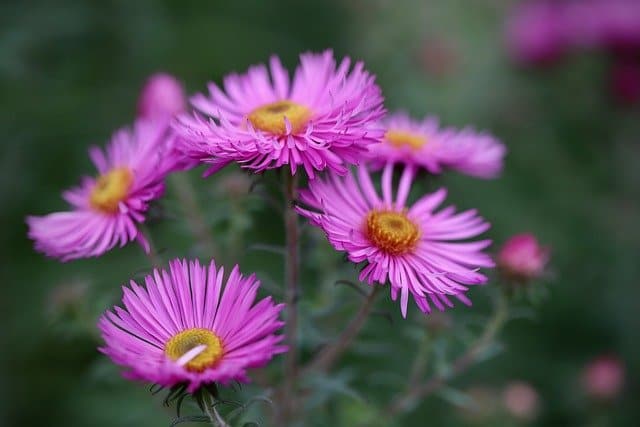
Asters are daisy-like flowers that come in a wide range of colors, including white, pink, purple, and blue. They bloom from mid to late summer and prefer full sun to partial shade.
Pansies (Viola × wittrockiana)
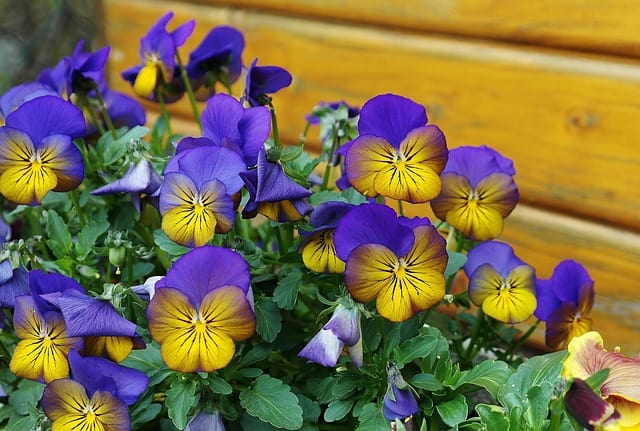
Pansies are one of the most popular Fall flowers because they come in such a wide range of colors and patterns. They bloom from mid-spring through early summer and then again in Fall. Pansies prefer full sun but can tolerate partial shade.
Black-Eyed Susans (Rudbeckia)
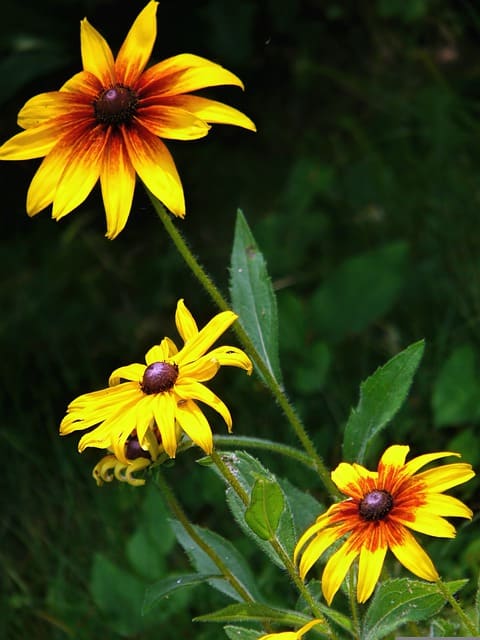
Black-eyed Susans are bright, cheerful flowers that add a pop of color to any garden or hanging basket. They bloom from mid to late summer and prefer full sun but can tolerate partial shade.
Coneflowers (Echinacea spp.)
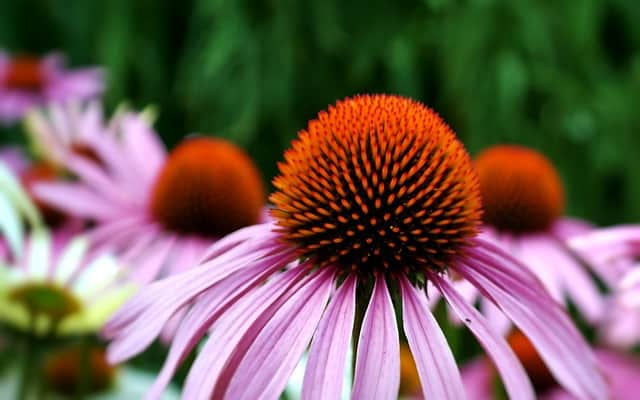
Coneflowers are long-blooming perennials that come in a wide range of colors, including white, pink, purple, and orange. They Bloom from early summer through early fall and prefer full sun but can tolerate partial shade.
Million Bells (Calibrachoa group)
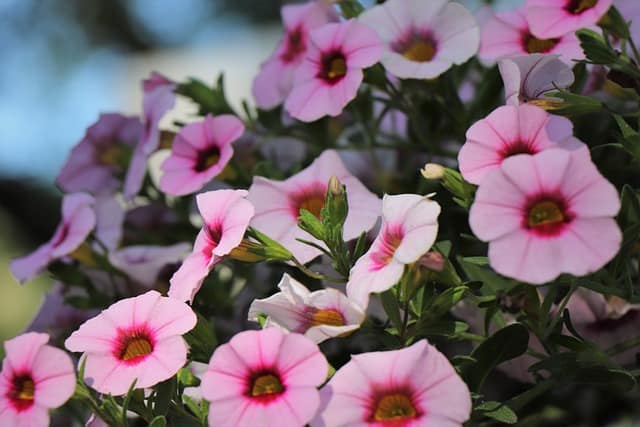
Million bells are small, trumpet-shaped Flowers that come in a wide range of colors, including white, pink, yellow, purple, and red. They bloom continuously from spring until first frost and prefer full sun but can tolerate partial shade.
Ornamental Sedge (Carex)

Ornamental sedge, specifically varieties such as Carex morrowii or Carex comans, is an ideal candidate for hanging baskets during the fall season. These grasses bring a blend of elegance and resilience to any display. Their arching foliage can come in various shades, including green, gold, and variegated forms, adding a lush and dynamic texture that sways gently in the autumn breeze.
One of the primary benefits of using ornamental sedges in hanging baskets is their exceptional tolerance for varying conditions. They can thrive in partial shade, making them perfect for locations that receive less direct sunlight as the days shorten. Additionally, these hardy plants require minimal maintenance; they are drought-tolerant once established, and their dense root systems help prevent weeds from encroaching.
When designing your hanging basket with sedge, consider pairing them with other fall favorites such as pansies or trailing ivy. The combination of upright sedge with cascading flowers creates a pleasing juxtaposition that not only highlights the sedge’s structure but also brings a lively burst of color to your fall decor.
Heaths and Heathers (Calluna or Erica)
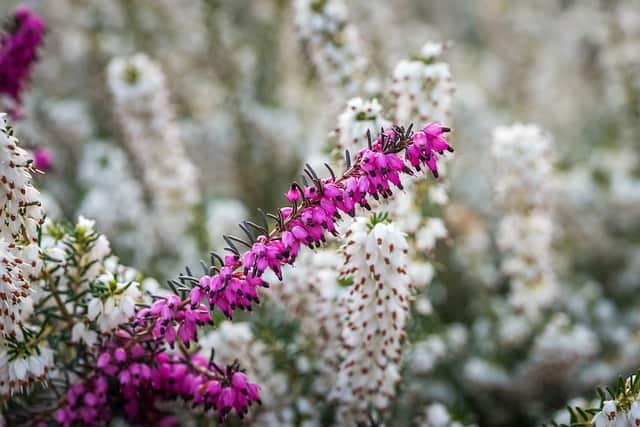
Heaths (Calluna) and heathers (Erica) are quintessential fall plants that bring a delightful seasonal flair to hanging baskets. Renowned for their resilience and vibrant blooms, these plants come alive in shades of purple, pink, and white during the autumn. Their tiny, bell-shaped flowers create a soft, romantic look that can soften the harsh lines of outdoor spaces.
Both Calluna and Erica prefer acidic soils and thrive in full sun to partial shade, making them versatile options for various gardening conditions. One notable trait of heaths and heathers is their ability to attract pollinators, such as bees and butterflies, even in the cooler months, which enhances the biodiversity of your garden.
Incorporating these plants into your hanging basket displays can provide year-round interest, as they often keep their foliage throughout winter, transitioning beautifully into the colder months. For an added effect, combine heaths and heathers with ornamental grasses or berries from winter-hardy plants, creating a visually stunning composition that celebrates the beauty of fall and the upcoming winter season.
Mums (Chrysanthemums)
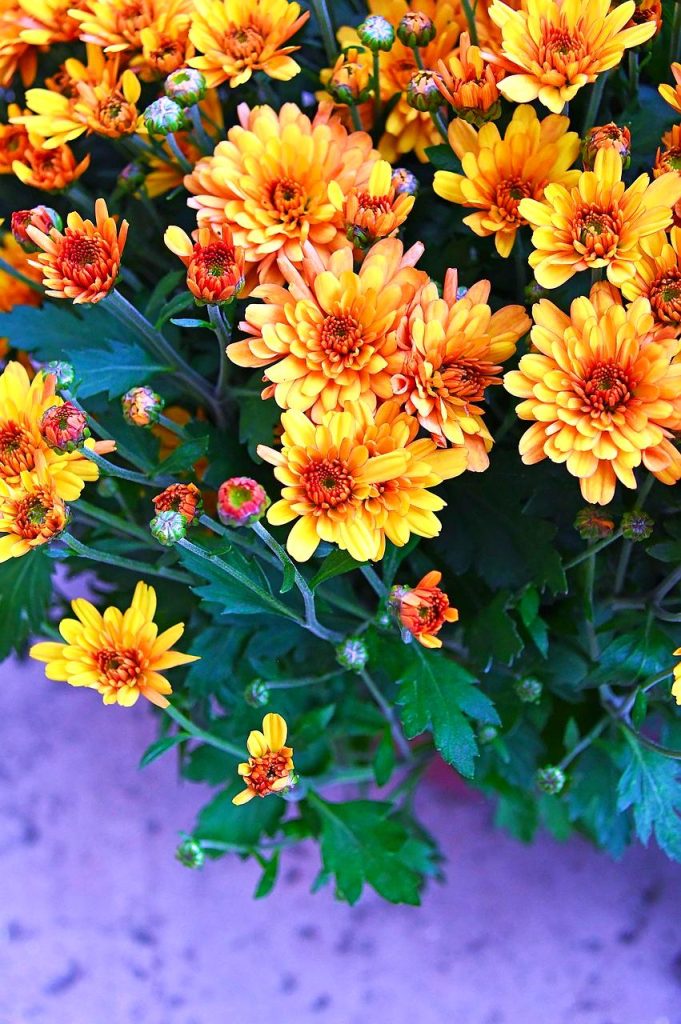
Mums, or Chrysanthemums, are undoubtedly the go-to fall plants when it comes to seasonal displays, and they excel in hanging baskets. Their broad variety of colors—ranging from soft pastels to vibrant jewel tones—makes them a fantastic addition to any fall setting. Mums are known for their dense clusters of blossoms, which can completely transform a simple basket into a burst of color and texture.
One fascinating aspect of Mums is their different blooming habits. Some varieties bloom early in the season, while others take their time, extending the visual appeal of your hanging baskets well into late fall. They thrive in well-draining soil and prefer areas with full sun, ensuring that their flowers remain vibrant and lush throughout the season.
Moreover, Mums are relatively easy to care for, requiring regular watering and deadheading to encourage new blooms. Combining Mums with ornamental grasses or trailing vines can create an eye-catching display that harmonizes with the autumn vibe. Just envision a basket brimming with golden-yellow Mums spilling over the edges alongside trailing greenery; it’s a captivating sight that embodies the fall spirit.
Snapdragon (Antirrhinum)
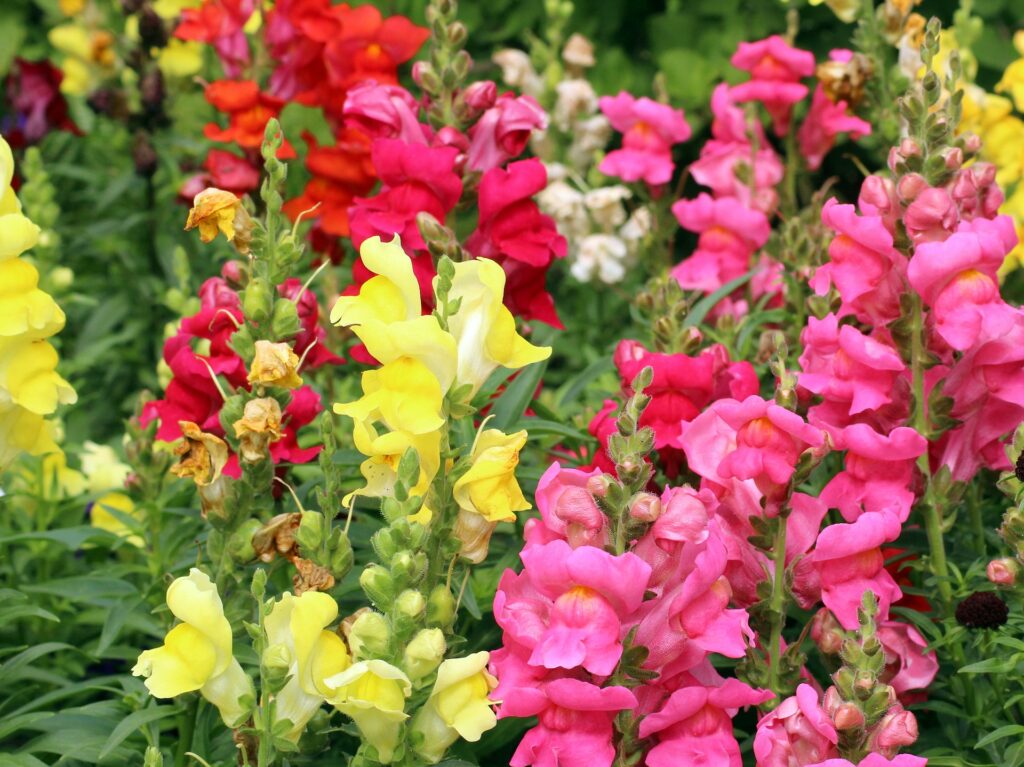
Snapdragons, or Antirrhinum, bring a touch of elegance and whimsical charm to hanging basket arrangements in the fall. Their unique, tubular flowers come in a plethora of shades, including rich reds, vibrant oranges, and soft yellows, creating lively contrasts that are perfect for the season. Not only do they provide a lovely aesthetic, but snapdragons also feature unique blooms that resemble tiny dragon mouths, adding an element of fun to your displays.
These hardy annuals prefer cooler temperatures, making autumn the perfect environment for their growth. Snapdragons thrive in full sun and well-drained soil, and they are often appreciated for their vertical growth habit, which can add height and dimension to hanging baskets. Their flowers can also stand up to light frosts, extending their blooming period well into the fall.
Planting snapdragons alongside shorter plants or mounding flowers enhances the overall visual impact of your baskets. Consider pairing them with low-growing pansies or fall-colored Petunias for a multi-layered look that captures the essence of fall while remaining visually striking. The charming faces of snapdragons will undoubtedly delight anyone who passes by, making your hanging baskets the talk of the neighborhood.
Verbena (Verbena)
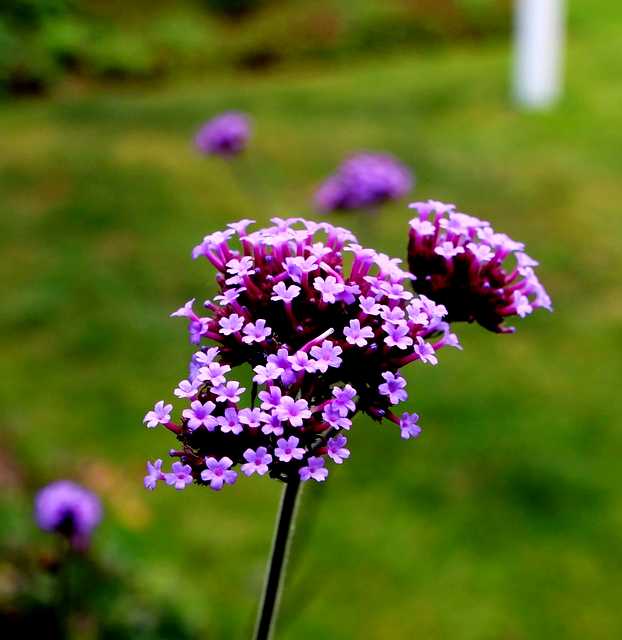
Verbena is another highly adaptable plant that shines in hanging baskets during the fall season. Renowned for their prolific blooming, Verbenas produce clusters of flowers that range in colors from deep burgundy to soft lavender and brilliant white. This extensive color palette allows for infinite combinations, enabling you to create hanging baskets that suit your personal style and add flair to your outdoor spaces.
One of the standout characteristics of Verbena is their trailing growth habit, which makes them ideal for spilling over the edges of hanging baskets. They thrive in full sun and well-drained soils, and their drought-tolerant nature means they hold up well even as the weather gets cooler. Regular deadheading promotes continuous blooming, ensuring that your baskets remain a vibrant focal point well into the fall months.
For an impressive seasonal arrangement, combine Verbena with trailing plants, such as Ivy or Sweet Potato Vine, which can enhance the cascading effect. Alternatively, mix them with ornamental kale or late-blooming dahlias to create a visually captivating and textural experience. Verbena’s ability to fill spaces quickly and adapt to various environments makes them a fantastic choice for those looking to elevate their fall hanging baskets.
Ornamental Cabbage and Kale (Brassica oleracea)
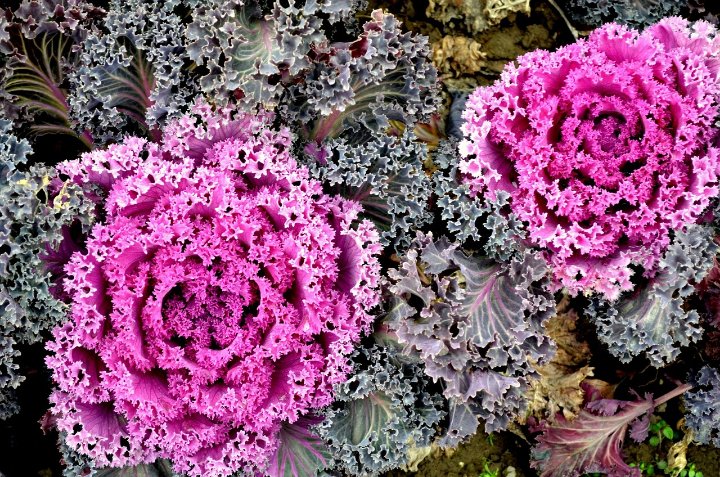
Ornamental cabbage and kale, commonly known as Brassica oleracea, provide a dramatic and artistic flair to hanging baskets during the fall season. Renowned for their visually striking foliage, these plants come in a range of colors, including rich purples, deep greens, and bright white. Their ruffled leaves create a captivating texture that adds depth and interest to any arrangement.
What sets ornamental cabbages and kales apart from many traditional ornamental plants is their impressive resilience in cold temperatures. While many flowering plants begin to fade as the weather cools, these hardy brassicas thrive and often become more vibrant as they experience frost. This makes them a fantastic candidate for hanging baskets that will be on display well into the winter months.
For an enticing display, consider mixing ornamental cabbage and kale with trailing plants or seasonal berries, which can add vibrant color contrasts and variety in height. They pair exceptionally well with seasonal elements, incorporating the essence of fall. These plants can transform your hanging basket into a seasonal masterpiece, inviting intrigue and admiration from all who see it.
Pansies (Viola)
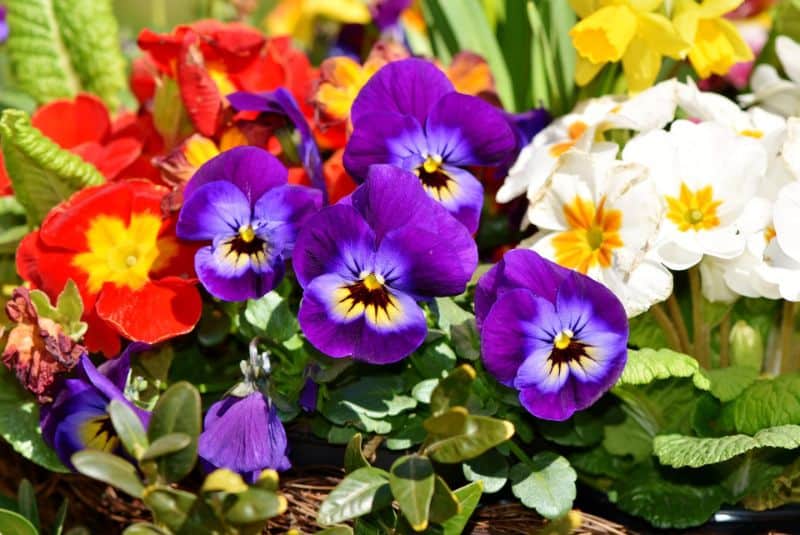
Pansies, scientifically known as Viola, are synonymous with fall gardening and are perfect for hanging baskets. These cheerful flowers contribute an explosion of color, available in a remarkable spectrum that includes bold yellows, deep purples, and soft pastels. Their iconic, heart-shaped petals boast striking patterns and a delightful fragrance, instantly uplifting any space.
One of the key advantages of pansies is their ability to withstand unpredictable autumn weather. They thrive in cooler temperatures and can even endure light frosts, making them a long-lasting option for fall arrangements. Additionally, pansies are known for their versatility, as they will bloom profusely throughout the fall and into early spring, providing continuous beauty to your hanging baskets.
To maximize the visual appeal of your pansy arrangements, mix them with lower-growing ground covers such as Creeping Jenny or lime green Dichondra. The contrast in colors and textures enhances the overall vibrancy of the basket, creating an eye-catching display that celebrates the fall season. Pansies are excellent conversation starters, drawing admiration with their cheerful faces and lively hues.
Million Bells (Calibrachoa)
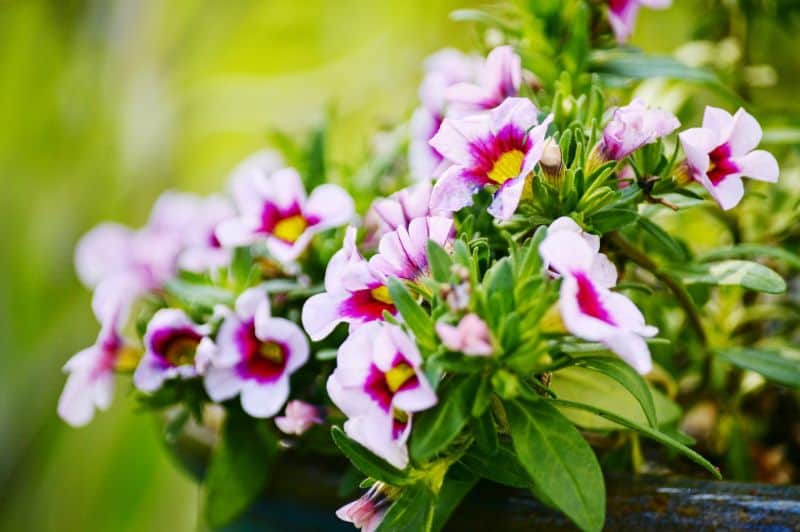
Million Bells, or Calibrachoa, are an increasingly popular choice for fall hanging baskets, boasting a profusion of small, charming trumpet-shaped flowers. These flowers come in an extensive array of colors, including bright pinks, yellows, and blues, and create a stunning cascade of color that can brighten even the cloudiest autumn days. Their prolific blooming habit ensures that the baskets are continuously covered in flowers throughout the season.
In addition to their appealing aesthetics, Million Bells are surprisingly easy to care for. They thrive in full sun and well-draining soil, making them an excellent choice for hanging baskets that are both exposed to sun and sheltered from extreme elements. They are also low-maintenance, requiring only regular watering and occasional fertilization to promote abundant blooming.
To enhance the beauty of your hanging baskets, consider combining Million Bells with other fall-tolerant flowers such as snapdragons or ornamental grasses for added texture and charm. Their cascading growth habit pairs well with trailing plants, creating a lush, flowing aesthetic that draws the eye. The combination of colors and forms will ensure your hanging baskets are a stunning focal point throughout the fall and welcome the cooler months with cheerful vibrance.
Ivy (Hedera helix)
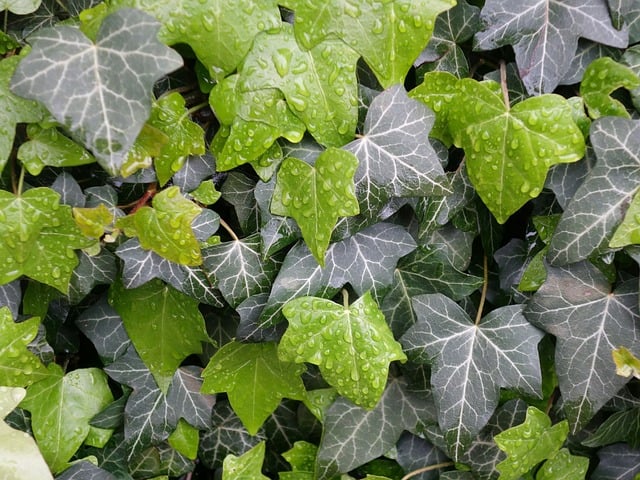
Ivy, or Hedera helix, is a classic choice for hanging baskets, offering timeless elegance and exceptional versatility. Known for its lush, trailing vines, ivy provides a rich green backdrop that drapes gracefully over the edges of baskets, creating a cascading effect that adds depth to any arrangement. Its glossy leaves are not only visually appealing but also serve as a solid base for additional seasonal plants.
One of the remarkable features of ivy is its adaptability. This hardy plant can thrive in various light conditions, ranging from full sun to partial shade, making it perfect for versatile placements in hanging baskets. Additionally, ivy can tolerate a range of soil types, provided they are well-draining, which means they can flourish in numerous garden settings.
Ivy also boasts air-purifying properties, making it a beneficial addition to any outdoor space. When combined with other fall plants, such as ornamental cabbage or vibrant pansies, it can serve as both a filler and a companion, softening the harsh lines of other plants while complementing their colors. The classic nature of ivy makes it an elegant choice to frame your hanging basket designs, providing continuity and cohesion in your fall displays.
Sedum
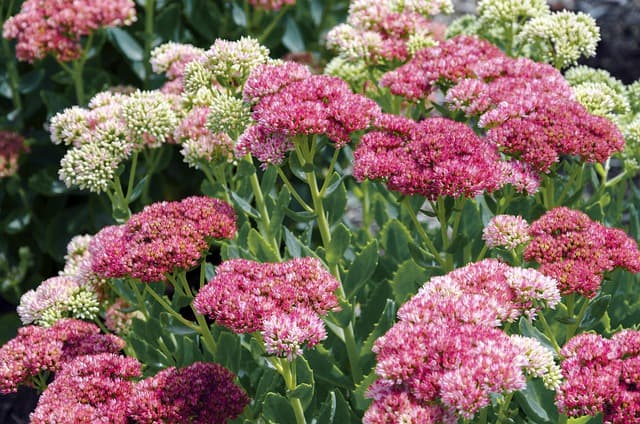
Sedum, often referred to as stonecrop, is an excellent choice for hanging baskets, especially for gardeners seeking low-maintenance yet visually striking plants for autumn. Known for its fleshy leaves and succulent appearance, sedum adds a unique texture that contrasts wonderfully with the softer blooms of traditional fall flowers. The diversity among sedum varieties allows for a plethora of creative combinations; some feature eye-catching reddish hues, while others are bright green or gold.
One of the key benefits of using sedum in hanging baskets is its drought resistance. These hardy succulents require minimal water once established, making them perfect for fall arrangements that may experience fluctuating temperatures. Sedums prefer sunny locations and well-draining soil, thriving in conditions that would be challenging for more delicate flowering plants.
The versatility of sedum as a container plant is remarkable; this perennial can blend seamlessly into arrangements with trailing vines, such as Million Bells or ivy, while providing a grounding element with its robust form. For a stunning fall display, consider pairing sedum with ornamental grasses or contrasting blooms like pansies. The combination of sedum’s architectural structure with other softer elements creates a beautiful balance, enhancing the beauty of your hanging baskets throughout the fall season.
Wintergreen, Checkerberry (Teaberry)
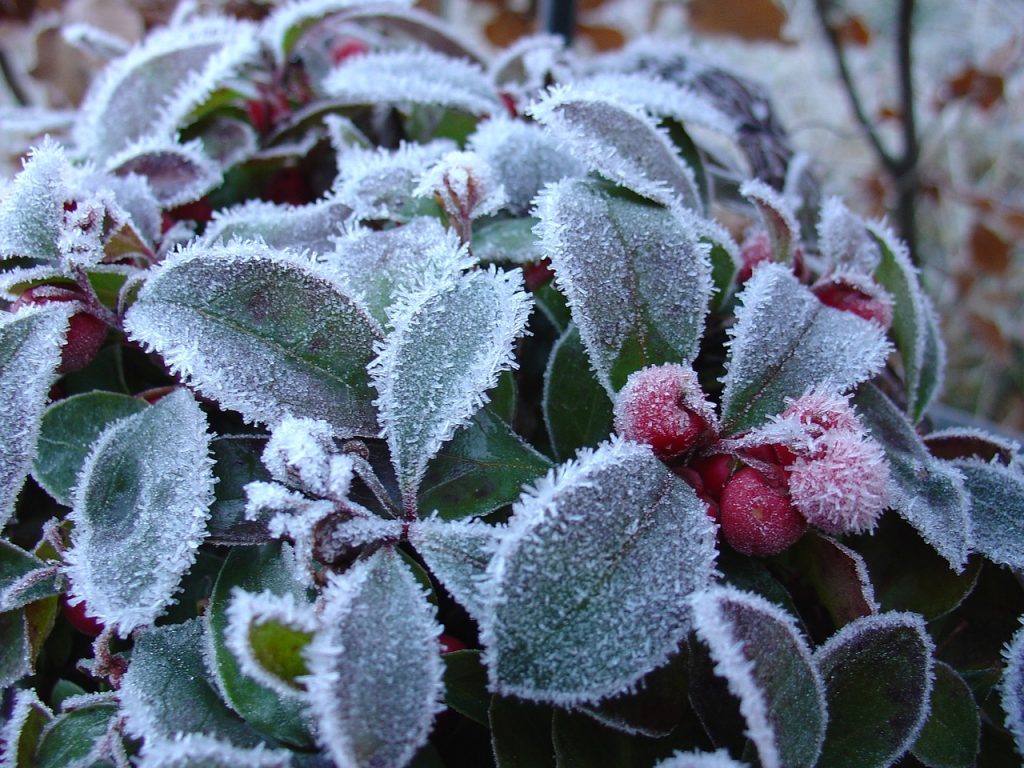 procumbens), brings an entirely different set of features to your fall hanging baskets. This evergreen groundcover plant is valued for its glossy green leaves and small, red berries, which stand out beautifully against the autumn backdrop. The leaves release a minty aroma when crushed, making Wintergreen a sensory delight in addition to its aesthetic appeal.
procumbens), brings an entirely different set of features to your fall hanging baskets. This evergreen groundcover plant is valued for its glossy green leaves and small, red berries, which stand out beautifully against the autumn backdrop. The leaves release a minty aroma when crushed, making Wintergreen a sensory delight in addition to its aesthetic appeal.
Wintergreen thrives in shaded to partially shaded areas, which makes it a perfect candidate for hanging baskets in spots that may not receive full sunlight. This adaptability allows you to create diverse arrangements that can endure another season of changing light. Additionally, this plant can tolerate various soil types, provided they are well-draining and rich in organic matter.
When incorporating Wintergreen into your baskets, consider mixing it with other shade-tolerant plants such as ferns or trailing ivy. This combination will create a lush, textured effect that will hold its appeal throughout the fall and winter months. The vibrant berries add a festive touch, enhancing the overall seasonal charm of your hanging baskets and inviting admiration from all who pass by.
Mint

Mint (Mentha) is often overlooked as a hanging basket plant, but it makes an exquisite addition that combines beauty with functionality. Renowned for its aromatic leaves and vigorous growth, mint can cascade elegantly over the edges of a basket, providing both visual interest and delightful scent. Available in a multitude of varieties, including spearmint, peppermint, and chocolate mint, each type brings its own unique flavor profile and fragrance to the arrangement.
One of the most appealing aspects of growing mint in hanging baskets is its adaptability to various light conditions. While it thrives in full sun, mint can also tolerate partial shade, which makes it versatile for different locations. Its trailing habit allows it to flourish and spill elegantly over the sides of the basket, creating a lush and inviting appearance.
Mint is also a fantastic choice for culinary enthusiasts. Harvesting fresh mint leaves for teas, cocktails, or garnishes becomes convenient when the plant is within arm’s reach. Additionally, mint can attract beneficial pollinators such as bees and butterflies, creating a lively habitat along with the beauty of the hanging arrangement. When planting mint, be mindful of its rapid growth; it can become invasive if planted directly in the garden. In hanging baskets, however, its rambunctious nature can be effectively managed, providing a strikingly fragrant addition to your autumn display.
Fall Hanging Basket Plant Care
Proper care is essential to maintain the vibrancy and health of your fall hanging baskets through the season. Here are some key tips to ensure your plants thrive as the weather cools:
Watering: As the fall months progress, monitor the moisture levels in your hanging baskets. While it’s essential to keep the soil evenly moist, avoid overwatering, which can lead to root rot. Check the top inch of soil regularly; if it feels dry, it’s time to water. Early morning is usually the best time to water your baskets before the sun’s heat can cause rapid evaporation.
Fertilization: While many seasonal plants benefit from regular fertilization, balance is key in fall. Use a slow-release formula to provide nutrients throughout the season. As autumn progresses and plants begin to slow in growth, transition to a lower-nitrogen formulation to support hardiness without encouraging excessive foliage growth.
Pruning and Deadheading: Regularly removing spent flowers (deadheading) encourages blooms in flowering plants like pansies and snapdragons. Additionally, prune any dead or yellowing leaves to maintain a tidy appearance and direct energy toward newer growth.
Location: Ensure your hanging baskets are placed in locations that provide adequate light for the plants you have chosen. Some plants prefer full sun, while others thrive in partial shade. Adjust the positioning of your baskets as needed to protect them from harsh winds or conditions, especially as temperatures begin to drop.
Protection from Frost: Be vigilant about frost forecasts during late fall. If a cold snap is expected, bring your hanging baskets indoors overnight or cover them with blankets or frost cloths to protect them from damage.
By implementing these care practices, you can ensure your fall hanging baskets remain vibrant and healthy, providing visual delight all season long.
Frequently Asked Questions
Q: Can I use the same soil for my hanging baskets as I do for my ground garden?
A: While you can technically use the same soil, it is advisable to use a high-quality potting mix specifically formulated for container gardening. Potting mixes tend to be lighter, provide excellent drainage, and contain nutrients that are beneficial for potted plants.
Q: How often should I water my hanging baskets in the fall?
A: The frequency of watering depends on environmental factors, but a good rule of thumb is to check the soil moisture daily. In cooler fall temperatures, baskets may require less frequent watering than in the summer months. Aim to water when the top inch of soil feels dry to the touch.
Q: Can I plant perennial plants in my hanging baskets for fall?
A: Yes! Many perennials can thrive in hanging baskets, including those with trailing habits like ivy or those that provide stunning fall colors like certain sedums. Just ensure they have adequate drainage, and consider their growth habits as your basket may need to be repotted in the future.
Q: Do I need to bring my hanging baskets inside during the winter?
A: Generally, it’s best to bring any non-hardy plants indoors if you live in a climate with cold winters. However, certain hardy perennials can survive outdoors with proper care. Assess the specific plants in your basket to determine the best winter plan.


